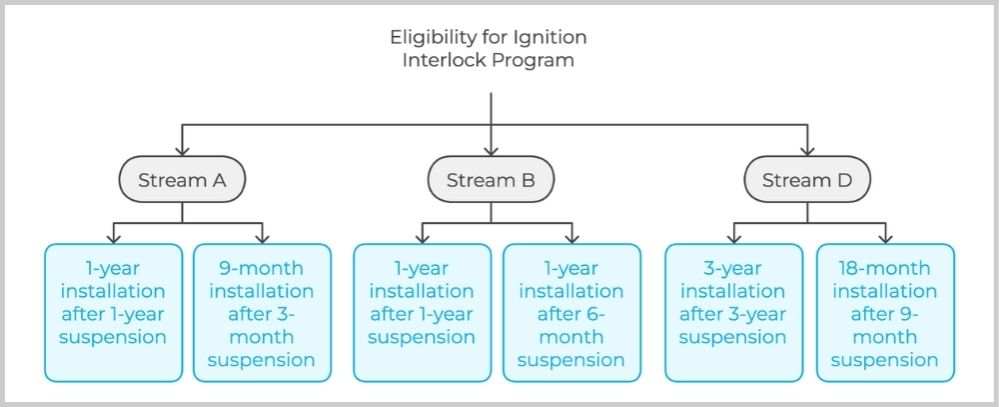Ontario’s Ignition Interlock Program: What You Need to Know!
Last Updated: September 5, 2024
The ignition interlock program is a mandatory program that all drivers who have been convicted of an impaired driving offence or drivers who within 10 years have had three or more suspensions must partake in.
An ignition interlock device in Ontario must be installed in your vehicle if you continue to drive once a license has been reinstated. As an in-car alcohol breath screening device, this mechanism is enabled to prevent the engine from starting if it detects alcohol in your system.
Notably, if you choose not to partake in this program by not installing an interlock device, then you will be prohibited from driving until the condition is removed from your license.
What is the Ignition Interlock Program?
If you are a driver who has been convicted of an impaired driving offence, or if, within 10 years, you have had three or more suspensions, then you must partake in the ignition interlock program.
An interlock device is essentially a breathalyzer device that tests for alcohol levels by utilizing an alcohol breath screening device that must be installed on your vehicle.
Before you can start your vehicle, you must blow into the device. If a blood alcohol concentration (BAC) is found to be over the preset limit of 0.02, then the vehicle will not start. If you are found to be below this level then the vehicle will start, however, you will be prompted to provide a breath sample at random times while the vehicle is on.
Before beginning the program, you must ensure that you no longer have any other license suspensions, such as unpaid fines or medical conditions, as well as that any other prohibitions have been removed.
Eligibility for the Ignition Interlock Program

There are three streams in the program, each with its eligibility requirements.
- Stream A: Stream A is for first-time offenders who have entered a guilty plea and were convicted or found guilty, sentenced and subject to a driving prohibition order within 90 days of the offence date. Two components of the program application, the remedial measures program assessment and the lease agreement with the service provider, must be completed within 3 months of the sentencing date.
- Standard Highway Traffic Act Penalty: Ignition interlock device must be installed for a minimum period of 1 year following a license suspension for 1 year.
- Reduced Suspension Program: The ignition interlock device must be installed for a minimum period of 9 months following a minimum of 3 months of license suspension.
- Stream B: Stream B is for first-time offenders who do not meet all the requirements of Stream A.
- Standard Highway Traffic Act Penalty: Ignition interlock device installed for a minimum of 1 year following a 1-year license suspension.
- Reduced Suspension Program: Ignition interlock device installed for a minimum of 1 year following a license suspension for a minimum of 6 months.
- Stream D: Stream D is for second-time offenders who have entered a guilty plea to the offence and are convicted or found guilty, resulting in a sentence and subject to driving prohibition order within 90 days of the offence date. Two components of the program application, the remedial measures program assessment and the lease agreement with a service provider, must also be completed.
- Standard Highway Traffic Act Penalty: Ignition interlock device installed for a minimum of 3 years following a 3-year license suspension.
- Reduced Suspension Program: Ignition interlock device installed for a minimum of 18 months following a minimum 9-month license suspension.
Other eligibility requirements for this program are as follows:
- Due to an alcohol-impaired driving conviction, your license has been suspended for 1 or 3 years
- As per the Highway Traffic Act, if you are a first or second-time offender
- If your license is suspended due to a prohibition order that is longer than 1 year for first-time offenders or 3 years for second-time offenders
- There was no impairment by drugs or a combination of drugs and alcohol in the offence
- You were not convicted of an offence where bodily harm or death was caused
- You were not convicted of driving while disqualified
- You are not subject to a prohibition on driving with an ignition interlock device through a court order
- You are not subject to a prior condition on your licence of driving with an ignition interlock device
- You have not been permitted to a previous reduction of an indefinite license suspension to10 years

Installation and Use of the Ignition Interlock Device
Steps to Install the Device in Your Vehicle:
To have the device installed into your vehicle, you must register with one of the government-approved interlock service providers. For further information on the installation process, maintenance of the device and costs, please visit the below government-approved interlock service providers:
Notably, the device will record all activity when it is in use, and every 60 days, these recordings must be downloaded and calibrated by the service provider.
How the Device Functions:
Once the device is installed, before you can start your vehicle you will be required to blow into the device. The device will then measure your blood alcohol concentration level (BAC), and if it is above the preset limit of 0.02, then the vehicle will not start. If the BAC level is below the preset limit of 0.02 then the vehicle will start, however, you may be required to provide breath samples at various intervals while your vehicle is running.
The device further has the capabilities of issuing a warning, recording the event and activating specific alarms such as flashing lights or honking horn until the ignition is turned off in the case that your BAC level exceeds the preset limit of 0.02 or if you refuse to provide a sample.
Legal Implications and Compliance
Legal Requirements for Using the Ignition Interlock Device:
The Ontario impaired driving laws state it is mandatory for a driver to partake in the Ignition Interlock Program if the driver is convicted of a drunk driving offence or if they have received three administrative suspensions within 10 years. A designation will be placed on a license once the conditions of the conviction have been fulfilled.
Penalties for Non-Compliance or Tampering With the Device:
For a conviction of tampering with the device or driving without the device then you will face a fine in the below range:
- $200-$1,000 for other motor vehicles (other than commercial vehicles)
- $200-$20,000 for commercial vehicles
Your vehicle may also be impounded for a violation of your ignition interlock conditions. The length of the impoundment will vary based on the following:
- If you are partaking in the program due to a Criminal Code conviction, then:
- For a first-time offence: impoundment of 45 days
- For a second-time offence: impoundment for 90 days
- For a third or subsequent offence: impoundment for 180 days
- If you are partaking in the program due to administrative suspensions, which is when you face suspensions three or more times within a 10-year time frame, you will then face impoundment for 7 days.
DUI penalties for failure to perform, which include having a BAC level above 0.02 or missing a breath sample that is requested at random during the drive, will result in an extended ignition installation period:
- For a first-time offence within the last 3 months: An additional 3 months from the current expiry date
- For a second-time offence: An additional 6 months from the current expiry date
Monitoring and Reporting Procedures:
Every 60 days, the device must be taken to the service providers so that the recordings that it makes when being used can be downloaded, and the device is then calibrated. This information is then used as a method to monitor your performance in the program.

Benefits of the Ignition Interlock Program
Some benefits of the ignition interlock program include, but are not limited to, reducing impaired driving rates as it ensures that drivers with previous histories of impaired driving cannot start their vehicles. In Ontario, approximately 80% of convicted impaired drivers are first-time offenders, and as shown by government studies, the ignition interlock program reduces recidivism. By encouraging the separation of an individual’s drinking from their driving, this program has been shown to reduce the impact of impaired driving on both the driver and other road users.
Frequently Asked Questions About Drug Offences
What is the Ignition Interlock Program in Ontario?
The Ignition Interlock Program is a program that allows any drivers who are convicted of a first or second impaired driving offence, should they meet the eligibility requirements, to reduce their license suspension in exchange for the ignition interlock device being installed in their vehicles as well as any other specific requirements.
Who is required to participate in the Ignition Interlock Program?
All drivers that have either been convicted of an impaired driving offence or, within 10 years, have been convicted three or more times for an impaired driving offence (administrative suspensions) are all mandated to participate in this program to continue being able to drive.
How does an ignition interlock device work?
Before you start your vehicle, you will be required to blow into the ignition interlock device, essentially doing a breathalyzer test. If your blood alcohol concentration (BAC) level is above the preset limit of 0.02, then you will be unable to start your vehicle. If your BAC level is lower than this preset limit then you will be able to start your vehicle, however, you will be required to breathe into the device at random times while the vehicle is running.
Notably, if refusing to provide a sample or if your BAC level is over this limit, then the device has capabilities such as issuing a warning, recording the event, and activating specific alarms such as flashing lights and a honking horn, which will stop once the vehicle is turned off.
How do I get an ignition interlock device installed in my vehicle?
An ignition interlock device must be installed in your vehicle by a government-approved service provider.
What are the costs associated with the Ignition Interlock Program?
The driver will be responsible for the installation and maintenance costs of the device. For more information, please see the below websites for government-approved service providers:
Conclusion
The ignition interlock program works as a DUI prevention program,m preventing recidivism. By ensuring that a convicted driver will not be able to drive their vehicle while impaired by alcohol, not only has this program promoted safety for the public but also for the individual. Partaking in this program has proven to be a vital step in separating one’s drinking habits from driving, proving imperative in society’s progression. For more information, please book a free consultation with one of our skilled DUI lawyers.
Get A Free Consultation
"*" indicates required fields



